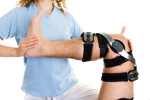Rehab a Injured Anterior Cruciate Ligament
 A torn ACL is an injury or tear to the anterior cruciate ligament (ACL). The ACL is one of the four main stabilising ligaments of the knee. The ACL attaches to the knee end of the Femur (thigh bone), at the back of the joint and passes down through the knee joint to the front of the flat upper surface of the Tibia (shin bone).
A torn ACL is an injury or tear to the anterior cruciate ligament (ACL). The ACL is one of the four main stabilising ligaments of the knee. The ACL attaches to the knee end of the Femur (thigh bone), at the back of the joint and passes down through the knee joint to the front of the flat upper surface of the Tibia (shin bone).
What should you do if you have injured your ACL?
- Immediately stop play or competition
- Apply RICE (Rest, Ice, Compression, Elevation) to the knee immediately
- Seek medical attention as soon as possible.
Your physician will diagnose any additional injuries, and you may be sent for an MRI scan or X-ray. You may be refered for ACL Surgery if required. Your physician will provide a pre-surgery rehabilitation program to strengthen the knee and reduce the swelling in preparation for surgery. This will help produce the best results following surgery.
The steps to proper rehabilitation will vary from case to case. The following is provided only as a reference and not a substitute for a physician’s diagnosis.
Immediately following surgery
- For approximately 2 weeks the initial protocol will be largely rest and use of crutches
- Ice and compression as before to reduce post-operative swelling
- Mobility exercises to regain full range of motion
- Hamstring stretching
- Strengthening exercises such as: quadriceps contractions, hamstring contractions and calf raises.
Two weeks following surgery
- Increase walking and aim for normal gait
- Continue mobility and strengthening exercises
- Progress hamstring curl exercises to using tubing or a resistance machine
- Introduce half squats and shallow lunges
- Start hip flexor strengthening and adduction and abduction exercises
- Balance and proprioception drills
- Continue icing after activity if swelling persists
Six weeks following surgery
- Progress to full lunges and squats, add weight for extra resistance
- Increase resistance/reps for strengthening exercises
- Single leg press or half squats
- Start straight line jogging
Twelve weeks following surgery
- Use a mix of training activities such as running, cycling, swimming to build aerobic fitness
- Gradually increase speed and duration of running
- Introduce running drills incorporating sideways and backwards running, change of direction and cutting maneuvers
- Jump and land drills
- Sports specific drills (e.g. football/hockey dribbling/passing)
- Continue with flexibility and strengthening exercises as before
often the patient will be given an exercise regime to continue even after being released from physical therapy and given the green light to return to normal activity.
For more information call the rehabilitation experts at Action Physical Therapy at 808-246-0144.
For more info, please visit the Sports Injury Clinic online.



